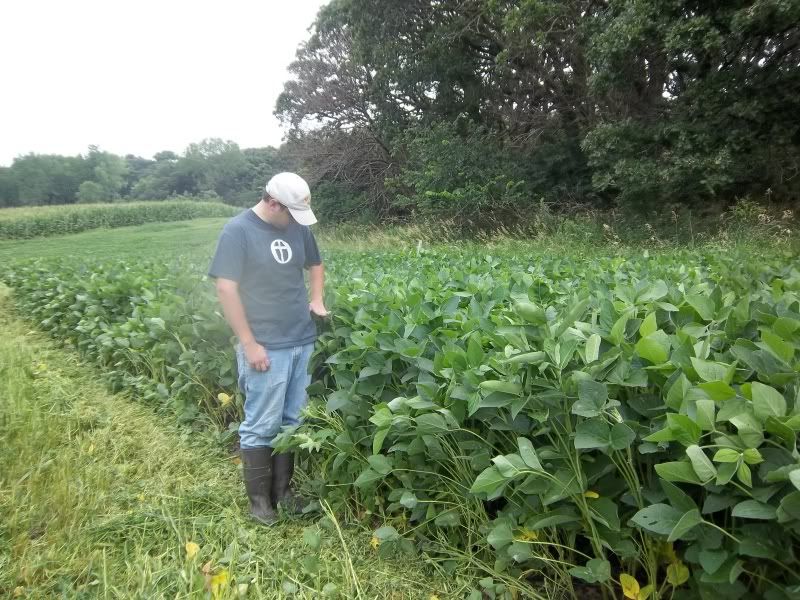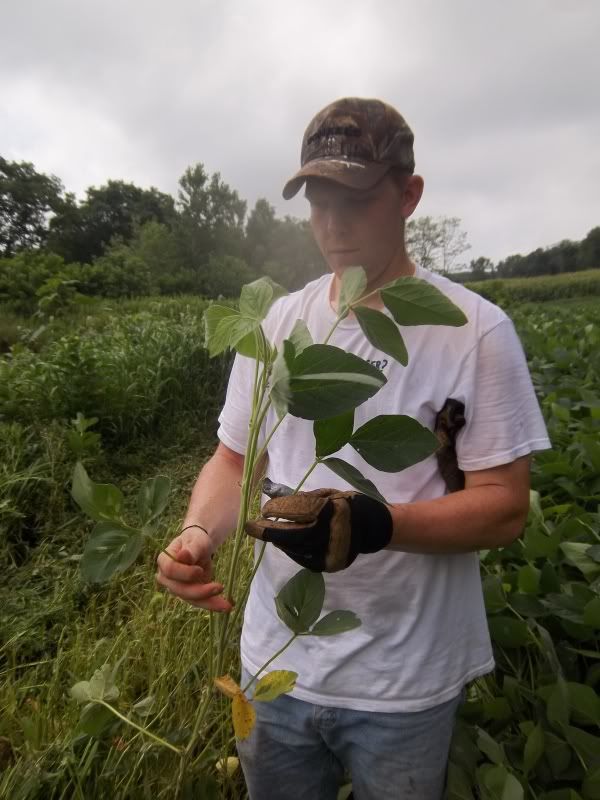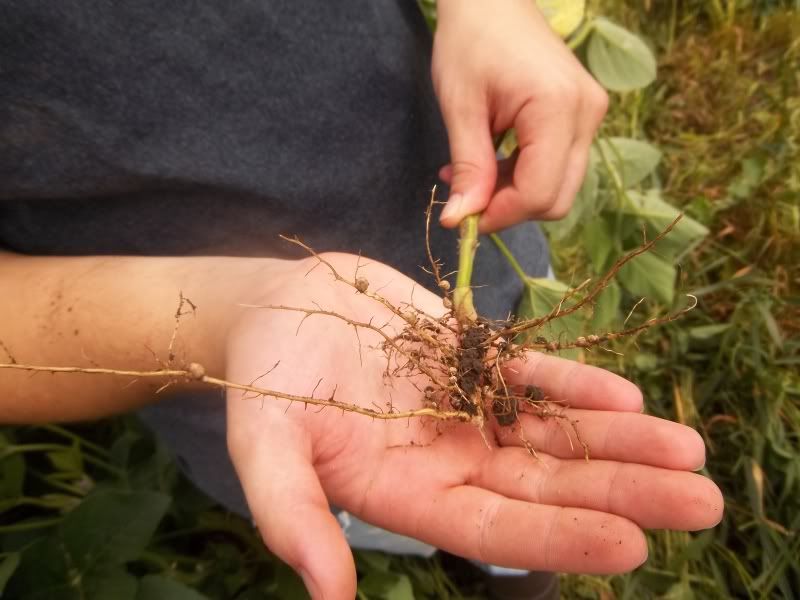I know this is a stupid question but i dont know... What is the difference between ag. and forage beans?
Funny you would ask just as I was about to share the following....
 Facts about soybeans
Facts about soybeans
The following information is meant to help landowners in the upper Midwest make intelligent and knowledgeable habitat decisions when considering soybeans. The information is centered on the following assumptions:
1) That your “hunting season” is centered around the rut period (first 2 weeks of November) and/or late season hunting in late December through mid January.
2) That you live in an area of the country that would expect to receive a killing freeze in early to mid October.
3) That your primary reason for considering soybeans is to provide optimum attraction during the time periods mentioned above.
4) That you have a desire to produce the maximum amount of feed from a minimum amount of acres yet provide a constant, year around source of feed at the least cost.
This information does not apply if…
1) You live in the deep south where growing seasons are long and a killing freeze may not occur.
2) You prefer to hunt only in the early season (late September to mid October)
3) Your primary reason for considering soybeans is to produce summer forage
4) You have unlimited financial and land resources
I do not sell soybean seed nor do I buy it so I can share information and ideas unfettered by profit motivations or loyalties and simply share truthful information observed in the Midwest.
Ag soybeans are bred for grain production but naturally produce copious amounts of high quality forage.
Forage beans are bred for forage and can produce more forage per acre but in the Midwest, little or no bean production.
Fact: All soybeans go through a period when they are unattractive to whitetails, in effect rendering the plot or field useless for deer for 2-3 weeks.
Why?
Soybeans go through a drying down period in which the leaves will slowly start to yellow and eventually drop, then pods and the soybeans themselves will dry . Soybeans bred for grain production typically go through this process in late August through mid September, well ahead of most Midwest hunting seasons. The “useless” time is before hunting season and the grain will then be the highly sought after attractant during November and December, key hunting periods for big mature whitetails.
Soybeans bred for forage production do not dry down naturally and continue to stay green until it freezes which in most of the Midwest is going to be sometime in early to mid October. The “useless” period for forage soybeans then is for most of us, is not only in the middle of hunting season but the rut period itself! The last thing we want is for deer to move to a neighboring field where ag soybeans are dried down and ripe for the picking.
Fact…all soybeans (commonly used for whitetail attractants) will produce pods/soybeans but soybeans bred for grain production can produce 40-60 bushels of grain while forage soybeans in the Midwest will produce significantly less if any beans at all. While grain beans are rapidly putting on developing pods the forage beans will have none and by the time they start to develop pods it’s too late in the fall for them to fill.
Fact…whitetails seek out forages spring through early fall but as high energy grain and mast crops become available they turn to them in earnest. Acorns, corn and soybeans are the most common so whenever possible we want to have those highly attractive food sources available mid October through December. Even if forage soybeans have developed some beans, whitetails will refuse to feed on them until they have fully dried down which is often well after the peak rut period has passed.
Fact…whitetails typically can only utilize roughly 17% protein in their daily intake, clovers and common ag soybeans can easily meet that requirement with CP in the low to upper 20% range.
Fact…we cannot grow big deer, only age and genetics can accomplish that so offering more/higher protein does not translate to bigger antlers..if only it were that easy!
Fact…providing year around sources of high quality forages and grains in centralized, secluded, screened feeding areas, adjacent to premium bedding areas is extremely important to holding big whitetails on our property. This requires that we plant multiple food sources in those areas with perennial white clovers being a crucial corner stone in accomplishing this feat. Any combination of crops and natural food sources that can provide for all of a whitetails needs every day of the year is suitable.
Fact…the majority of landowners have limited acres with which to accomplish the about mentioned requirements which means they must be resourceful in putting together the right combinations. Ag soybeans dry down at the perfect time in late summer to allow us to overseed winter rye and forage radishes into them. As they yellow and dry down the rye and radish plants begin to grow and provide forage until the following spring. Combining the high yielding grain production of the ag soybeans with the rye and radishes then increases our overall yield and leaves not a day when deer our will not find food sources in that feeding area.
Forage soybeans do not dry down prior to hunting season so they stay canopied (unless decimated by over grazing) making over seeding impossible. Since they have very low grain yields, any beans will be quickly stripped leaving the plot bare and useless for the remainder of the winter until replanted the following spring. Other crops can of course be planted adjacent to keep deer coming to the plot but on limited acreage this transfers all the feeding to the remaining food sources, again limiting our ability to actually feed deer all year long.
Fact…given a hidden, secluded safe feeding area, whitetails will quickly adapt to feeding there an eventually will eat almost anything planted there.
Fact…if the feeding area becomes void of feed and an adjacent neighbors field has standing corn or soybeans whitetails will take advantage of that, adapting them to visiting the neighbors property making it imperative that we provide food sources that won't "run dry" because of low yields.
Fact…a bushel of soybeans weighs 60#’s so ag soybeans have the potential to provide nearly a ton of highly attractive feed per acre more then forage beans…critical in holding whitetails on our property during the fall and winter months.
Fact..the average 150# whitetail consumes 3-6#’s of feed per day much of which is natural forage but at 2#’s per day one acre of high yielding ag soybeans producing 50 bushel per acre (3000#’s) could provide 1500 days worth of feed. 20 whitetails consuming 40#’s per day could in theory have 75 days worth of feed on one acre of ag beans. Forage beans producing 10-20 bushel could feed 20 whitetails for less then two weeks, at which point they will leave to seek out other high energy food sources.
Because we can over seed the ag beans with winter rye we can maximize the usefulness of our plots, increase the carrying capacity, extend the grazing period to cover the entire winter and prevent whitetails from leaving our property.
Fact…with few exceptions, when ag soybeans and forage soybeans are planted in the same field, whitetails will eat all the soybeans with little preference for one over another. Take either one away and they will continue to feed happily on either.
Fact…soybeans (like all crops) should be rotated yearly so it is important to plan to have other nitrogen using crops such as corn, brassicas or cereal grains incorporated into our program. When at all possible include these crops within the same plot or field rather then in other fields so that deer become adapted to always traveling to the same feeding area 24/7, 365 days a year.
Planting in a strip crop fashion will help keep deer from decimating soybeans , lush white clover or rye and red clover will often allow soybeans to grow with out fencing.
Fact…forage soybeans have the ability to produce a tremendous amount of high quality forage but ag soybeans overseeded with rye have the ability to produce more high quality feed per acre over a longer period of time.
There are always exceptions to every rule and each landowner may experience unique situations regardless of which crops are planted so the facts given are just basic information to give landowners some insight in helping them make the choices that are right for them. No one thing is right for everyone and there are countless ways to create a great habitat program.
In the deep south where a killing freeze may not occur during hunting season, forage soybeans will continue to provide a source of forage and will produce beans because of the longer growing season. In the far north they may freeze out in mid September and may produce no beans at all leaving no draw at all during hunting season.
RR ag soybeans typically run $45-60 a bag and in most agricultural areas are available locally so shipping is not involved while forage soybeans may be 25-50% higher plus shipping costs. In most of the corn belt RR soybean seed is available through PF, NWTF and the DNR, for .50 cents to $10 a bag for handling.
Seed companies give leftover seed away yearly having no use for it after the growing season, giving it away for wildlife plantings allows them to write it off so don’t overlook the possibility of planting your RR beans for almost nothing….
































